Overview
The article titled "10 Trends in Health Care and Information Technology You Must Know" presents a commanding overview of the transformative trends reshaping the healthcare landscape through technology. Key trends such as:
- The rise of telehealth
- Artificial intelligence
- Data interoperability
- Cybersecurity
are explored in depth. These advancements not only enhance patient care but also improve operational efficiency and bolster data security within healthcare systems. Supported by various statistics and expert insights, this article serves as an essential resource for understanding the pivotal changes in the industry.
Introduction
The landscape of healthcare is experiencing a seismic shift as technology redefines the delivery and experience of medical services. Custom software solutions that enhance user engagement, the rise of telehealth, and AI-driven analytics are not mere trends; they are essential components of a more efficient and patient-centered healthcare system. However, as organizations embrace these advancements, they confront significant challenges, including data interoperability and cybersecurity threats.
How can healthcare providers navigate this complex terrain while maximizing the benefits of emerging technologies? This article delves into ten pivotal trends in healthcare and information technology that are shaping the future of patient care and operational excellence.
SDA: Transforming Healthcare with Custom Software Solutions
SDA stands at the forefront of industry transformation, delivering custom software solutions meticulously designed to address the unique needs of service providers. By prioritizing user-centered design, SDA ensures applications are not only intuitive but also meet the requirements of both users and medical professionals. This focus on usability is crucial, as studies reveal that user-friendly interfaces significantly enhance user engagement and satisfaction.
The integration of cutting-edge technologies, including telehealth and data management systems, empowers medical organizations to optimize operations and elevate care for individuals. For instance, the implementation of a secure, web-based client payment portal has enabled providers to streamline billing processes, resulting in reduced administrative burdens and improved access to services.
Statistics underscore the impact of these innovations: the telemedicine market is projected to exceed $115 billion by 2024, reflecting a growing reliance on technology to bridge gaps in medical delivery. Moreover, 88% of U.S. office-based physicians have embraced centralized Electronic Health Records (EHR) systems, illustrating the shift towards digital solutions that bolster operational efficiency.
Industry leaders emphasize the importance of technology integration in healthcare. As articulated by a prominent medical developer, the evolution of health IT is revolutionizing traditional workflows, allowing providers to manage substantial volumes of client data with heightened speed and security. This transformation transcends mere tool adoption; it encompasses the creation of a that enhances outcomes for individuals and operational effectiveness.
SDA's commitment to developing tailored software that adapts to the ever-evolving landscape of medical services ensures organizations can navigate regulatory challenges and technological advancements with ease. By focusing on adaptable and scalable solutions, SDA empowers care providers to thrive in a competitive market, ultimately leading to improved client care and operational success.
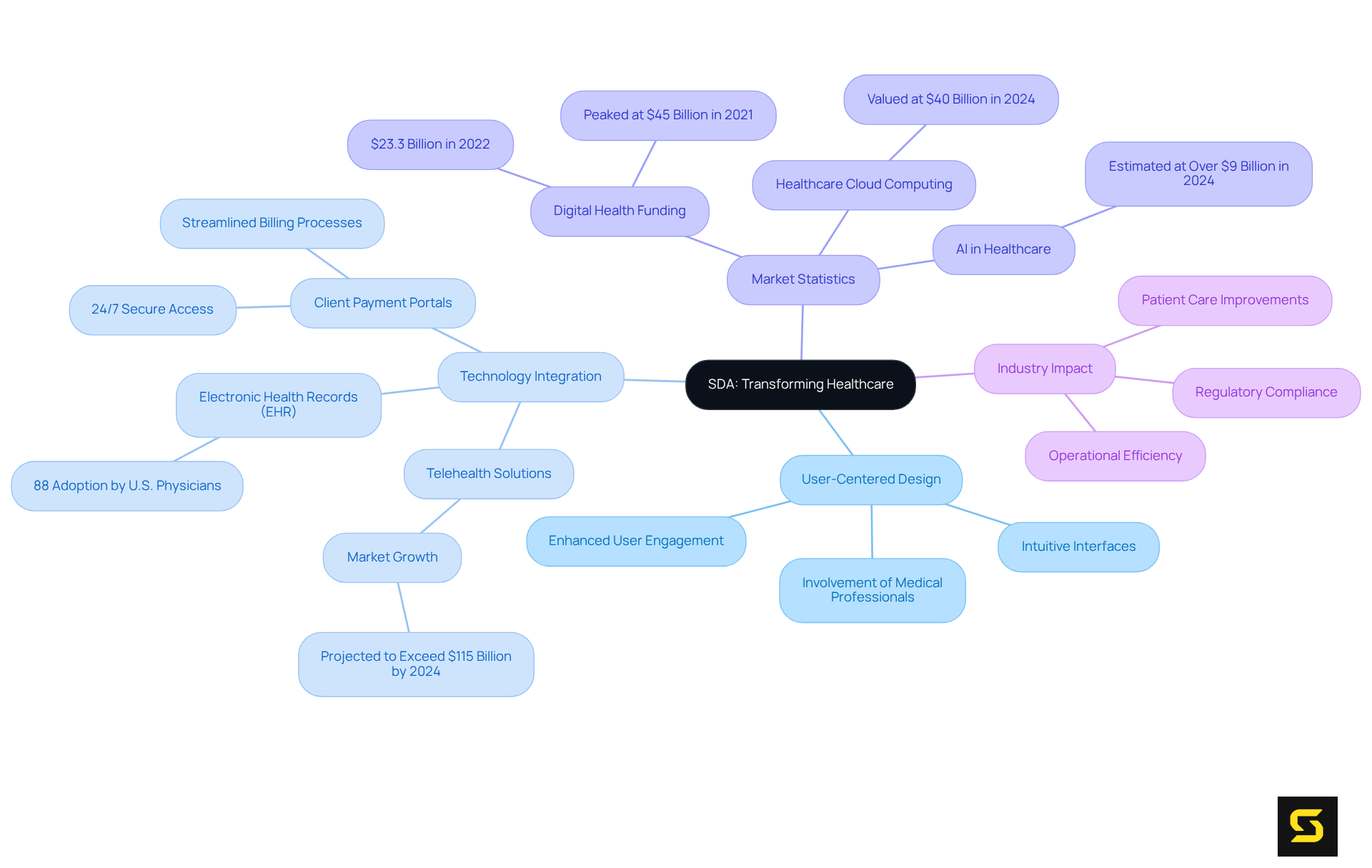
Telehealth: Revolutionizing Patient Consultations and Monitoring
Telehealth has emerged as a transformative force in health care and information technology, allowing individuals to consult with medical professionals remotely. This innovation not only enhances accessibility for those in rural or underserved areas but also alleviates the burden on health care and information technology facilities.
With advancements in video conferencing technology and secure data sharing, telehealth, which falls under health care and information technology, and timely interventions, ultimately resulting in improved health outcomes. Research indicates that individuals participating in remote monitoring programs demonstrate superior management of chronic conditions such as hypertension and diabetes, leading to reduced hospitalizations and readmissions.
Furthermore, the global telemedicine market was valued at USD 83.4 billion in 2022 and is projected to reach USD 327 billion by 2030, reflecting a remarkable compound annual growth rate of 19%. This growth underscores the increasing reliance on telehealth solutions, particularly in rural medical contexts where access to traditional services is limited.
Experts assert that health care and information technology, particularly through telehealth, not only enhances engagement among individuals but also fosters a more efficient delivery model, ultimately improving outcomes and patient satisfaction. As noted by a medical expert, 'Telehealth services can be offered by all qualified Medicare providers through September 30, 2025,' underscoring the ongoing commitment to integrating telehealth into care.
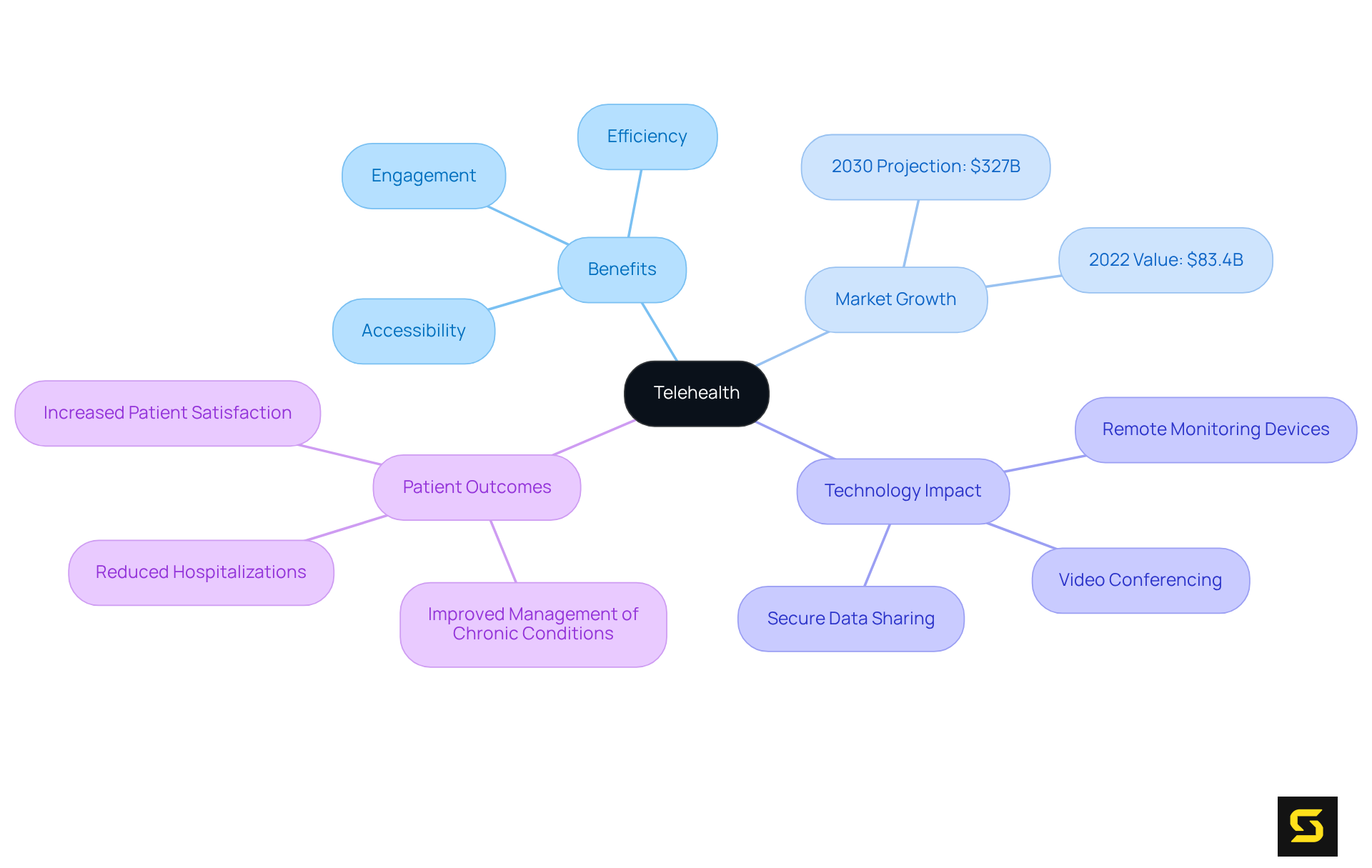
Artificial Intelligence: Enhancing Predictive Analytics in Healthcare
Artificial Intelligence (AI) is fundamentally transforming predictive analytics in medical services, enabling providers to anticipate individual needs and optimize resource distribution effectively. By leveraging historical data and identifying patterns, AI tools can forecast potential health risks, facilitating proactive interventions. This capability not only enhances care for individuals but also significantly boosts operational efficiency, making medical systems more responsive and effective.
By 2025, an estimated 80% of hospitals will employ AI to improve both individual care and workflow efficiency. Moreover, 40% of medical providers have reported enhanced efficiency due to AI solutions, indicating a rising trend towards data-informed decision-making. Successful implementations, such as those observed in NHS Dorset, which utilized generative AI to streamline clinical records, are projected to . This demonstrates AI's potential to conserve substantial time and resources, ultimately leading to improved outcomes for individuals.
Analysts predict that the incorporation of AI in medical services will continue to advance, with 85% of medical leaders intending to invest in generative AI over the next three years. Barbara Staruk, Chief Product Officer at RLDatix, emphasizes that 2025 will be a pivotal year for AI technologies in medical services, underscoring its critical role in shaping the future of patient care.
However, challenges such as the need for transparent explanations of AI models and continuous monitoring must be addressed to ensure successful implementation. SaaS product owners should consider these factors when developing AI-driven solutions to enhance medical service delivery.
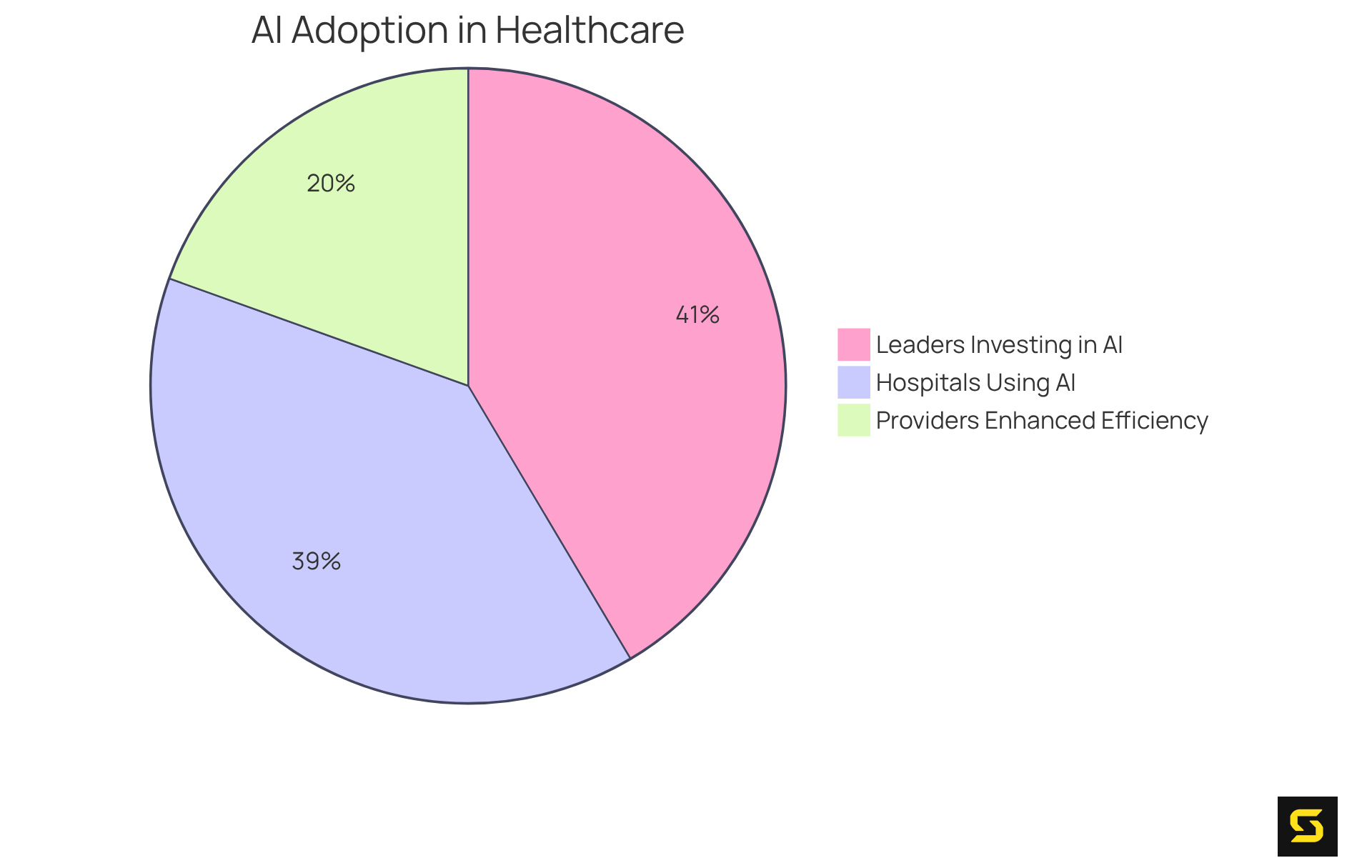
Data Interoperability: Streamlining Information Exchange in Healthcare
Data interoperability stands as a pivotal trend in health care and information technology, facilitating seamless information transfer among diverse health systems. This capability is essential for medical providers in health care and information technology to access comprehensive client information, significantly enhancing decision-making and care coordination. The Centers for Medicare & Medicaid Services (CMS) mandated interoperability regulations in April 2024, requiring EHR vendors to enable smooth information exchange. This initiative aims to bolster collaboration among healthcare providers and ultimately improve care outcomes by integrating health care and information technology.
As we approach 2025, the significance of information exchange in health care and information technology is underscored by the adoption of certified EHR systems by over 95% of non-federal acute care hospitals in the U.S., reflecting a remarkable shift towards digital health solutions. Noteworthy examples of successful information exchange include the collaboration between Epic Systems Corporation and Salesforce, which integrates individual records from EHRs with Salesforce Health Cloud. This partnership is set to enhance care coordination by equipping medical providers with comprehensive individual information, thereby improving outcomes for patients.
However, leaders in health care and information technology highlight the challenges in achieving effective data interoperability. Dr. Mehmet Oz, CMS Administrator, aptly noted, "For too long, individuals in this country have been encumbered by a healthcare system that has not evolved with the disruptive innovations that have changed almost every other sector of our economy." This statement underscores the ongoing and information technology to overcome barriers such as high upfront costs, interoperability issues, and resistance from clinical staff.
The impact of information interoperability on health care and information technology in 2025 is profound. By adopting standardized data formats and protocols, medical organizations can dismantle barriers to information sharing in health care and information technology, leading to improved outcomes for individuals. Enhanced access to medical information through health care and information technology empowers individuals to manage chronic conditions more effectively and adhere to treatment plans, ultimately fostering a more patient-centered system in health care and information technology. As medical organizations navigate these trends, SaaS Product Owners can leverage these insights to develop solutions that address interoperability challenges and enhance the overall user experience.
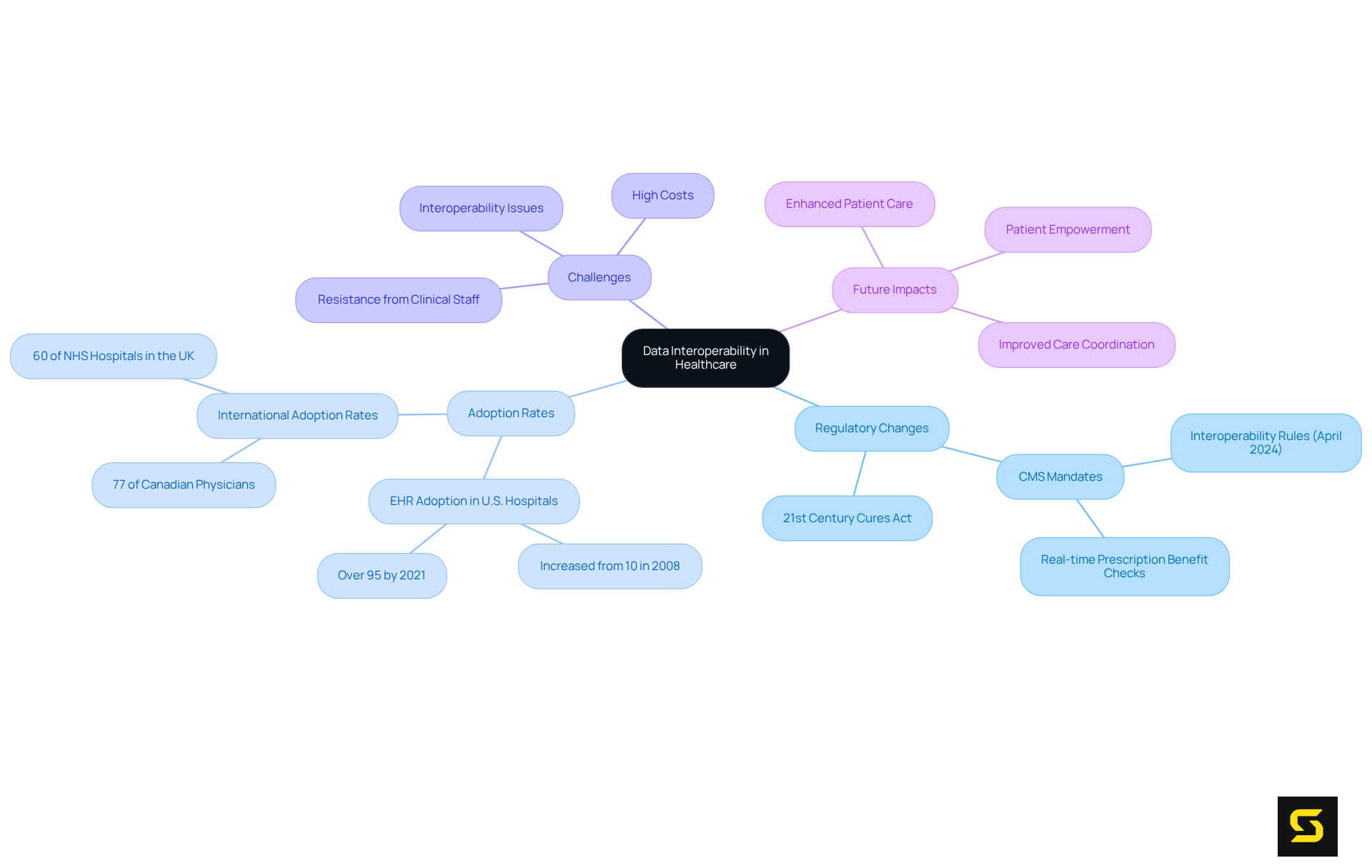
Wearable Technology: Empowering Patients with Real-Time Health Data
Wearable technology is revolutionizing individual by delivering real-time medical data that can be seamlessly tracked and shared with professionals in health care and information technology. Devices such as fitness trackers, smartwatches, and wellness monitors empower individuals to take a proactive role in their health management. This trend significantly enhances user engagement; during the COVID-19 pandemic, 66% of first-time wearable users utilized these devices for chronic condition management. Furthermore, a remarkable 80% of wearable users are willing to share their wellness information with doctors, highlighting a robust interest in collaborative management.
Healthcare providers reap the benefits of continuous access to individual data in health care and information technology, which facilitates more personalized care and informed treatment decisions. The integration of AI-driven analytics in wearables enables predictive insights, promoting proactive management in health care and information technology. Successful implementations of wearable devices in medical settings have proven their capability to reduce hospital readmissions by up to 30% and could potentially decrease hospital costs by as much as 16% in the forthcoming years, underscoring their effectiveness in improving patient outcomes.
As the global market for wearable medical devices was valued at USD 91.21 billion in 2024 and is projected to grow at a CAGR of 17.8% from 2025 to 2032, the future of medical services is increasingly intertwined with these innovative technologies.
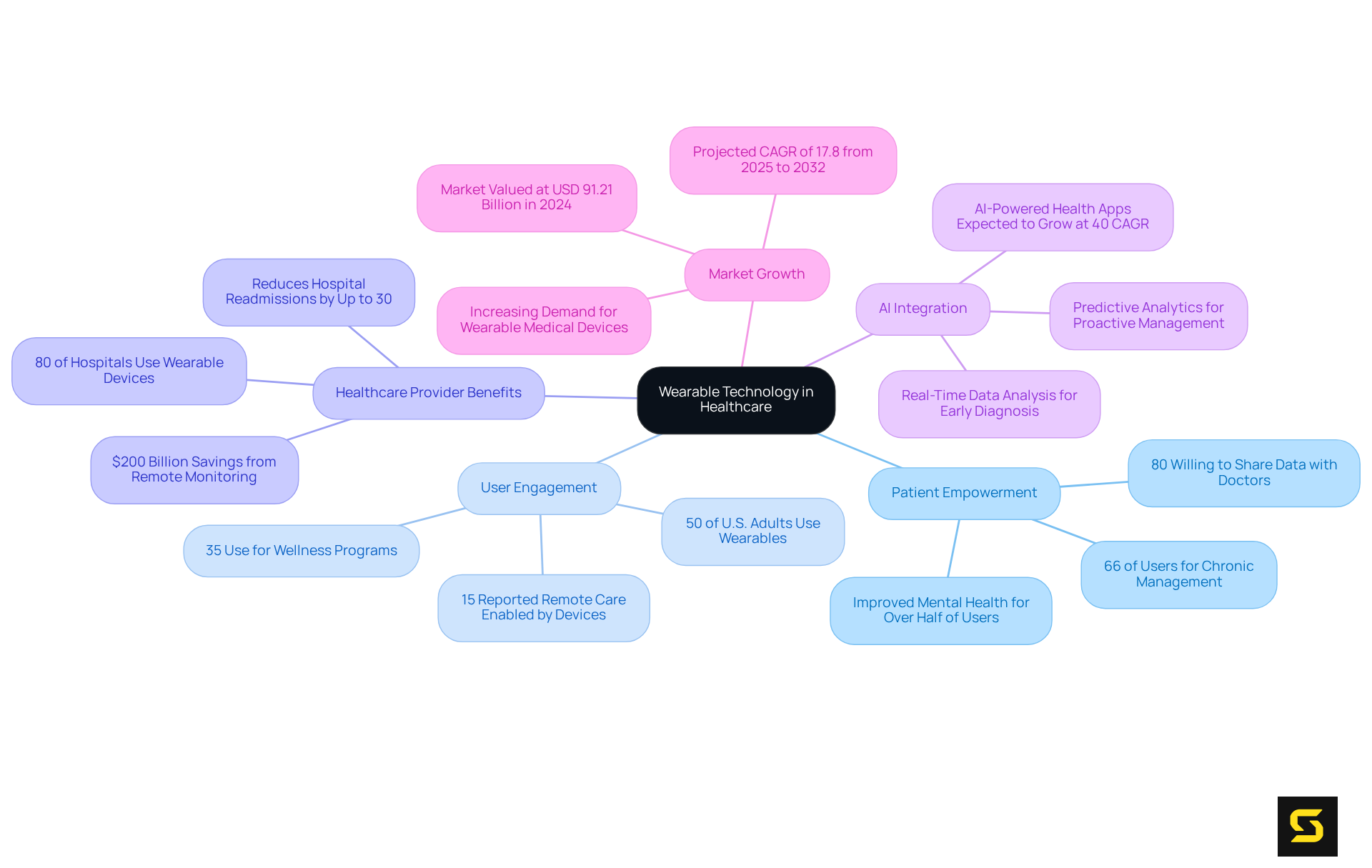
Cybersecurity: Safeguarding Patient Data in Healthcare Systems
As health care and information technology increasingly rely on digital technologies, the imperative of cybersecurity has never been more pronounced. Protecting patient information from breaches and cyberattacks is essential for maintaining trust and complying with regulations. In 2024, a staggering 92% of medical organizations reported being targeted by cyberattacks, up from 88% in 2023, highlighting the critical need for robust cybersecurity measures. Healthcare organizations must adopt comprehensive cybersecurity strategies related to health care and information technology, including:
- Encryption
- Access controls
- Regular security audits
to protect sensitive information and uphold the integrity of their systems.
The financial ramifications of data breaches are considerable, with the average cost per compromised medical record soaring to $408—significantly higher than the cross-industry average of $148. This financial strain underscores the urgency for medical organizations to invest in thorough cybersecurity frameworks. Notably, organizations in the health care and information technology sectors utilizing AI and automation tools in their cybersecurity efforts detected incidents 98 days faster, demonstrating the effectiveness of advanced technologies in mitigating risks.
Cybersecurity experts emphasize the necessity of proactive measures. John Riggi, a cybersecurity consultant for the American Hospital Association, asserts that 'any cyberattack on the healthcare sector that disrupts or delays care creates a risk to safety and crosses the line from an economic crime to a threat-to-life crime.' This perspective underscores the paramount importance of , as breaches can lead to enduring consequences, including identity theft and fraud.
Successful examples of protecting client information include organizations that have implemented:
- Multi-factor authentication
- Ongoing employee training
both of which are vital for reducing vulnerabilities. Additionally, the Biden administration's proposed $800 million funding in 2025 aims to bolster cybersecurity infrastructure specifically in hospitals, reflecting an increasing acknowledgment of the necessity for robust defenses against cyber threats.
In conclusion, the implementation of extensive cybersecurity strategies is not merely a regulatory requirement but a fundamental component of preserving trust and ensuring the safety of medical systems in an ever-evolving digital landscape.
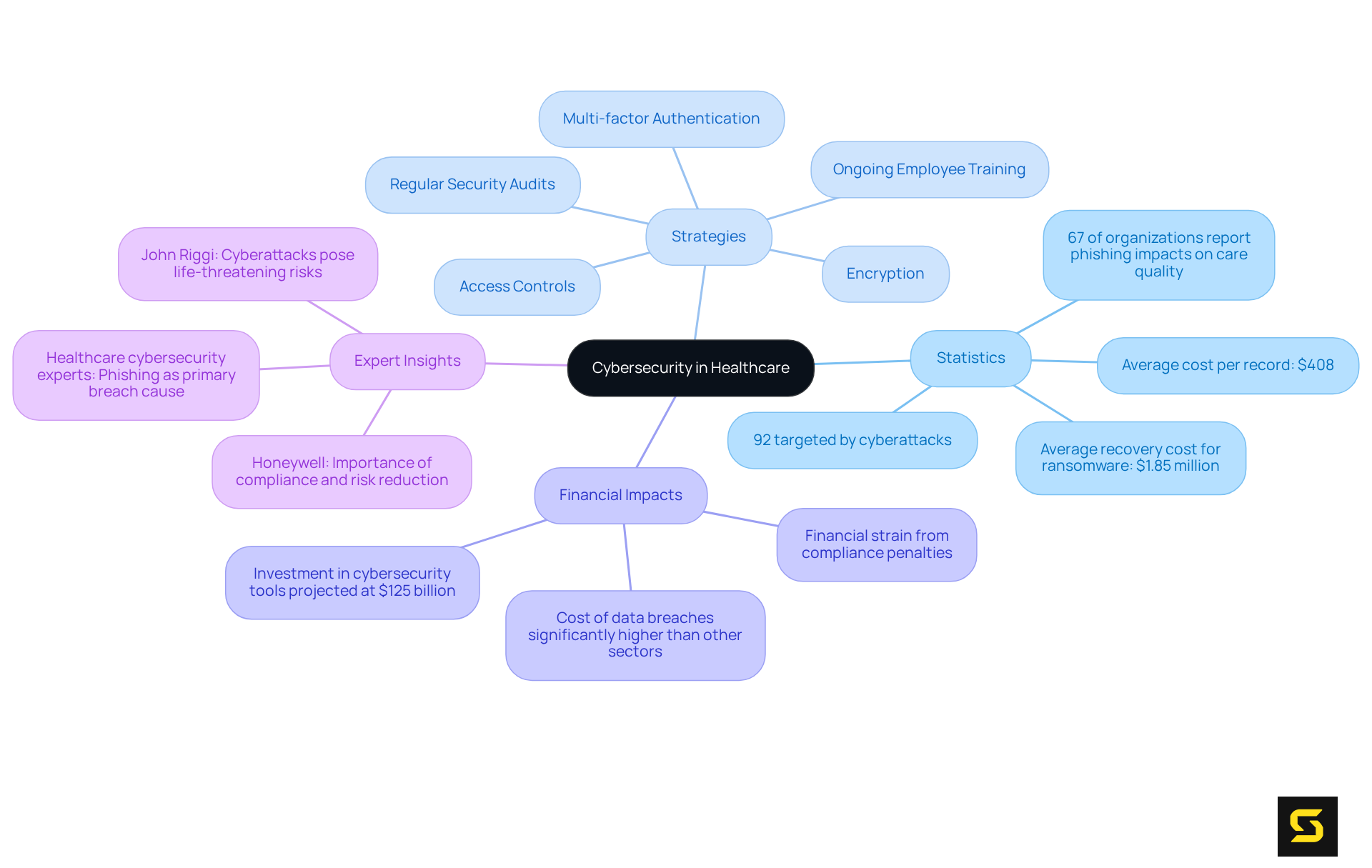
Cloud Computing: Enabling Scalable Data Solutions in Healthcare
Cloud computing is fundamentally transforming health care and information technology in the medical field by providing scalable and adaptable solutions for the storage and processing of vast medical data. This technology empowers medical organizations to access client information from any location, fostering enhanced collaboration among providers and improving health care and information technology delivery. The implementation of cloud-based electronic health records (EHRs) exemplifies this shift in health care and information technology, which significantly increases the accuracy and comprehensiveness of patient information through real-time updates and automatic validation, thereby reducing the risk of medical errors. Notably, a survey indicates that 83% of medical organizations are already utilizing cloud-based services, with an additional 9.3% planning to adopt them soon.
Moreover, cloud solutions not only lower operational expenses but also bolster information security, making them an appealing option for medical service providers in health care and information technology. Successful implementations, such as Mayo Clinic's use of Amazon Web Services (AWS), illustrate how cloud technology can streamline operations and facilitate secure data sharing. The migration of over 80 applications to the cloud resulted in a remarkable and reduced onboarding time to just 30 minutes, directly attributable to this migration.
IT leaders emphasize the critical role of scalability in health care and information technology solutions, highlighting that cloud computing enables organizations to efficiently adapt to increasing client volumes and administrative pressures. For instance, a customized clinic management system powered by generative AI has led to a 15% improvement in patient care efficiency and a 20% increase in physician productivity. As medical services continue to evolve, the integration of cloud technology will remain vital in enhancing health care and information technology management and operational efficiency. However, it is essential to address challenges such as data security and privacy to fully harness the benefits of cloud computing in the medical sector.
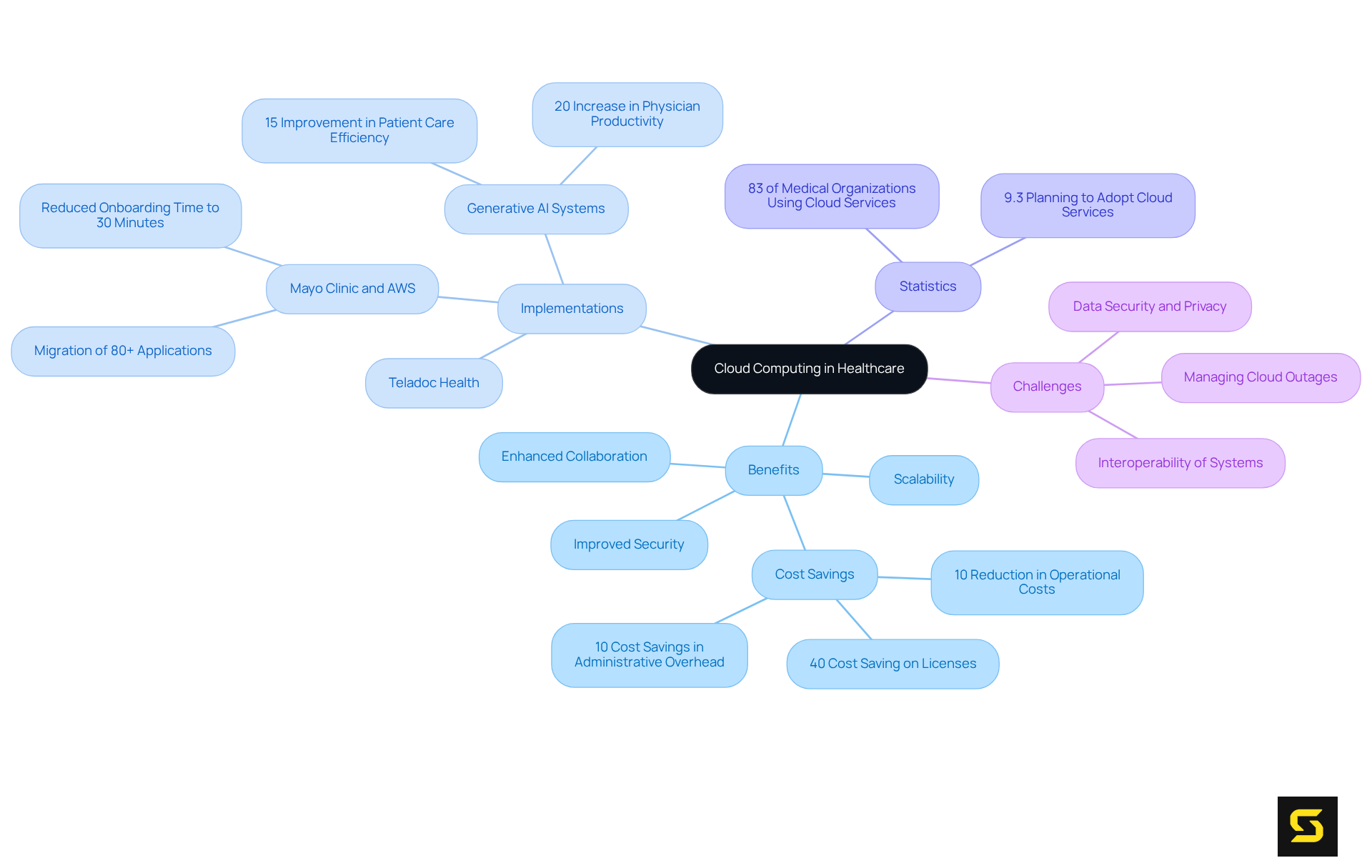
Patient Engagement Platforms: Enhancing Communication and Satisfaction
Engagement platforms are revolutionizing the interaction between healthcare providers and individuals within the realm of health care and information technology. These advanced tools facilitate two-way communication, allowing individuals to:
- Access their medical information
- Schedule appointments
- Receive timely reminders
By enhancing communication and equipping patients with essential tools to manage their well-being, these platforms not only elevate patient satisfaction but also contribute to improved health outcomes. It is imperative for healthcare providers to adopt these innovative solutions in health care and information technology to create a more engaged and informed patient population.
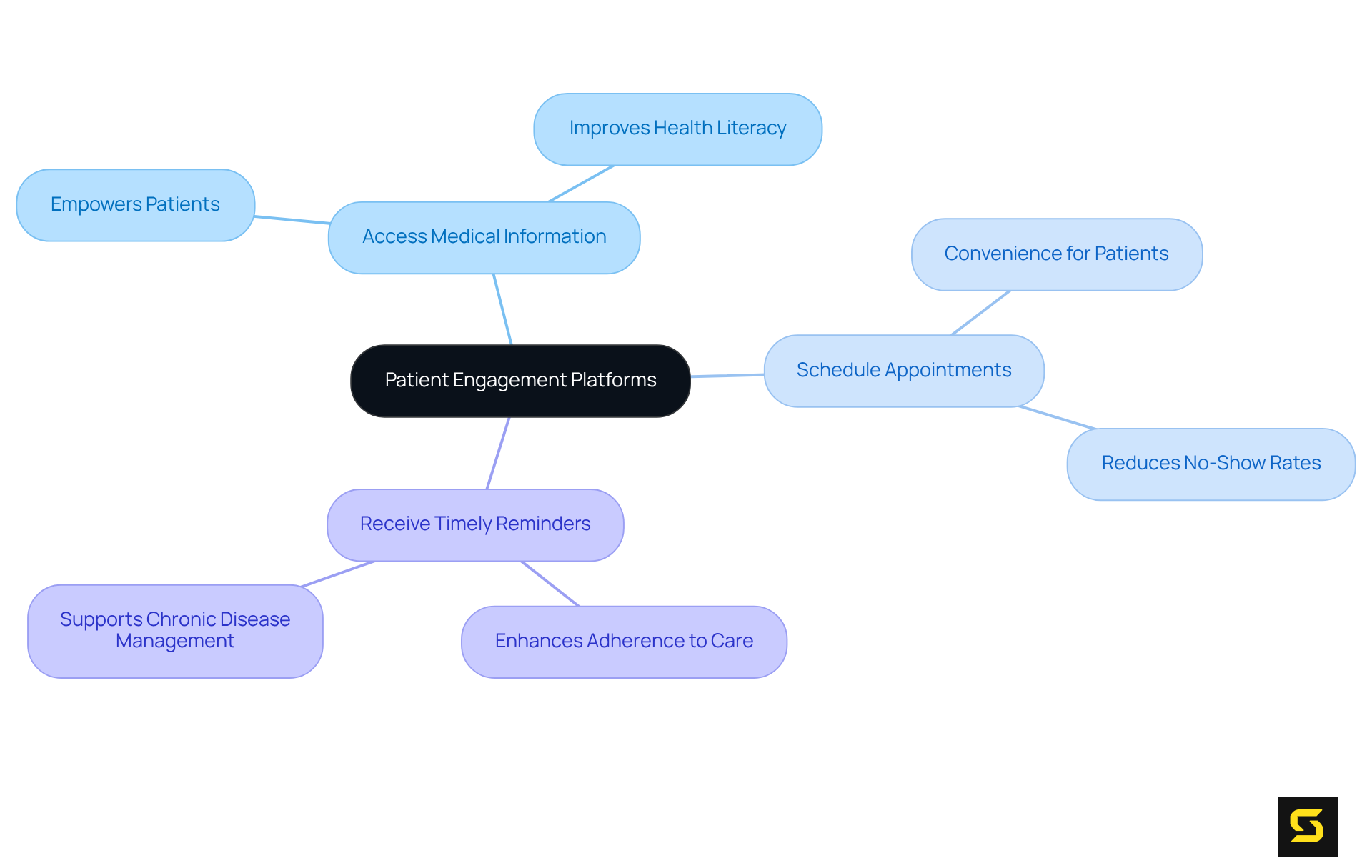
Blockchain Technology: Securing Health Records with Transparency
Blockchain technology is rapidly emerging as a crucial asset in safeguarding medical records and ensuring the integrity of information. By utilizing a decentralized and tamper-proof ledger, it markedly enhances transparency and accountability in medical record management. This innovative approach empowers patients by granting them control over access to their personal information, fostering trust and bolstering information security within medical systems.
Successful implementations of blockchain for medical records management have demonstrated its capacity to streamline processes and reduce fraud. A prime example is Avaneer Health's blockchain-supported network, which, bolstered by substantial funding, aims to improve payer-to-payer information sharing and eligibility verification. This illustrates how blockchain can significantly enhance operational efficiency in health care and information technology sectors.
Looking ahead to 2025, the impact of blockchain on medical record security is expected to be profound, with projections indicating that over 55% of medical applications will incorporate blockchain technology. This shift is driven by the urgent need to address the , which revealed over 41 million records in just the first half of 2023. The healthcare sector remains the most expensive domain for information breaches, as highlighted by Scott Doughman, who underscores the financial repercussions of these incidents and the imperative for robust security measures.
Technology leaders emphasize the importance of transparency in medical records, noting that blockchain's immutable characteristic provides a reliable framework for protecting sensitive information. By ensuring that medical records are secure and verifiable, blockchain not only protects individual data but also restores trust in health care and information technology management—an essential factor, considering that 95% of individuals express concerns about potential information theft or leaks.
In conclusion, blockchain technology is poised to revolutionize medical records management by enhancing security, ensuring transparency, and empowering individuals. SaaS product owners must consider integrating blockchain solutions into their offerings to maintain a competitive edge in this evolving landscape.
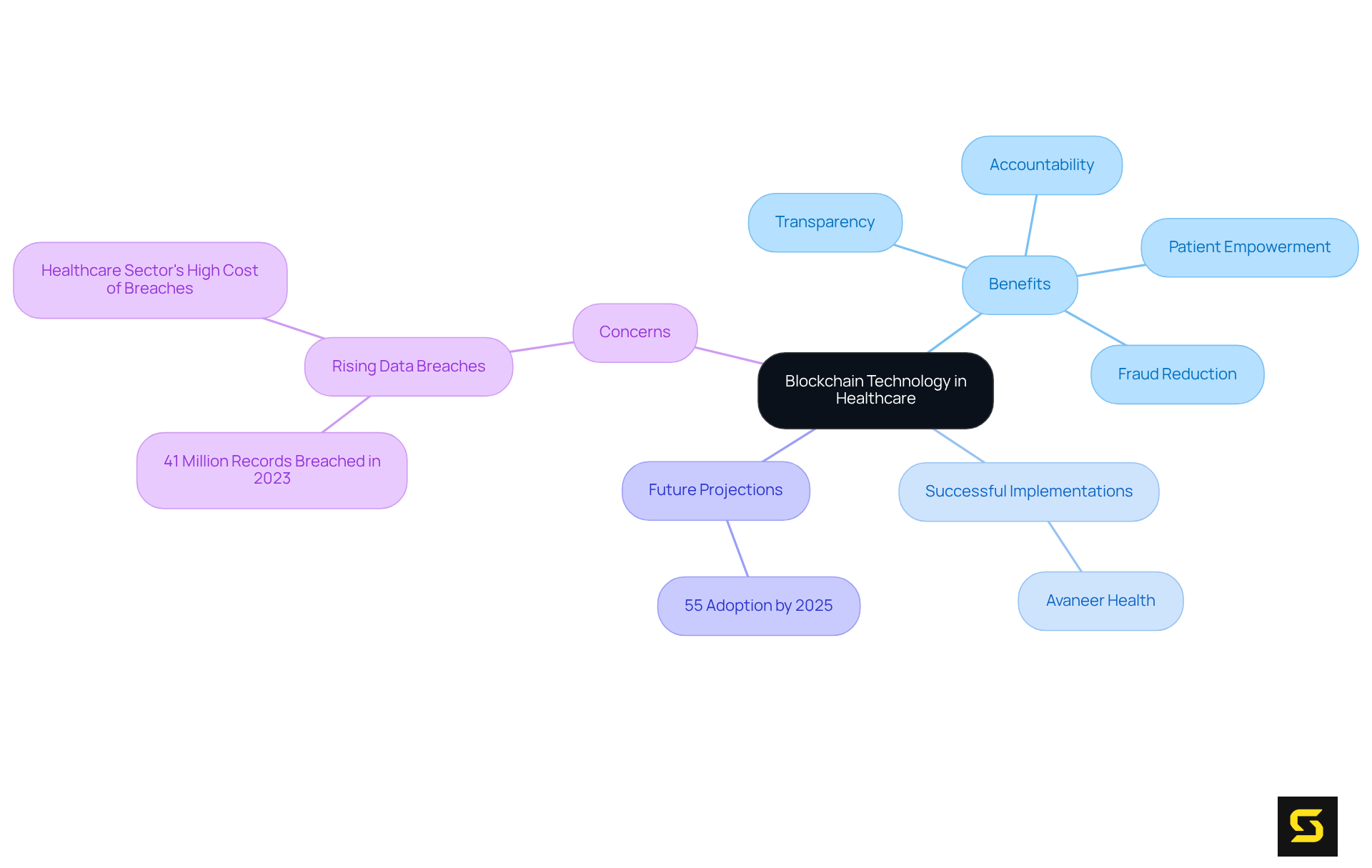
Big Data Analytics: Driving Informed Decision-Making in Healthcare
Big information analysis is revolutionizing the medical field, particularly in health care and information technology, empowering organizations to make informed decisions through comprehensive evaluation. By harnessing extensive health care and information technology data, providers can identify critical trends, optimize operations, and significantly improve patient outcomes. This enables organizations in health care and information technology to customize their services to address the unique needs of their patient populations, ultimately elevating the quality of care. Embrace this transformative approach to enhance healthcare delivery and ensure that your organization remains at the forefront of medical innovation.
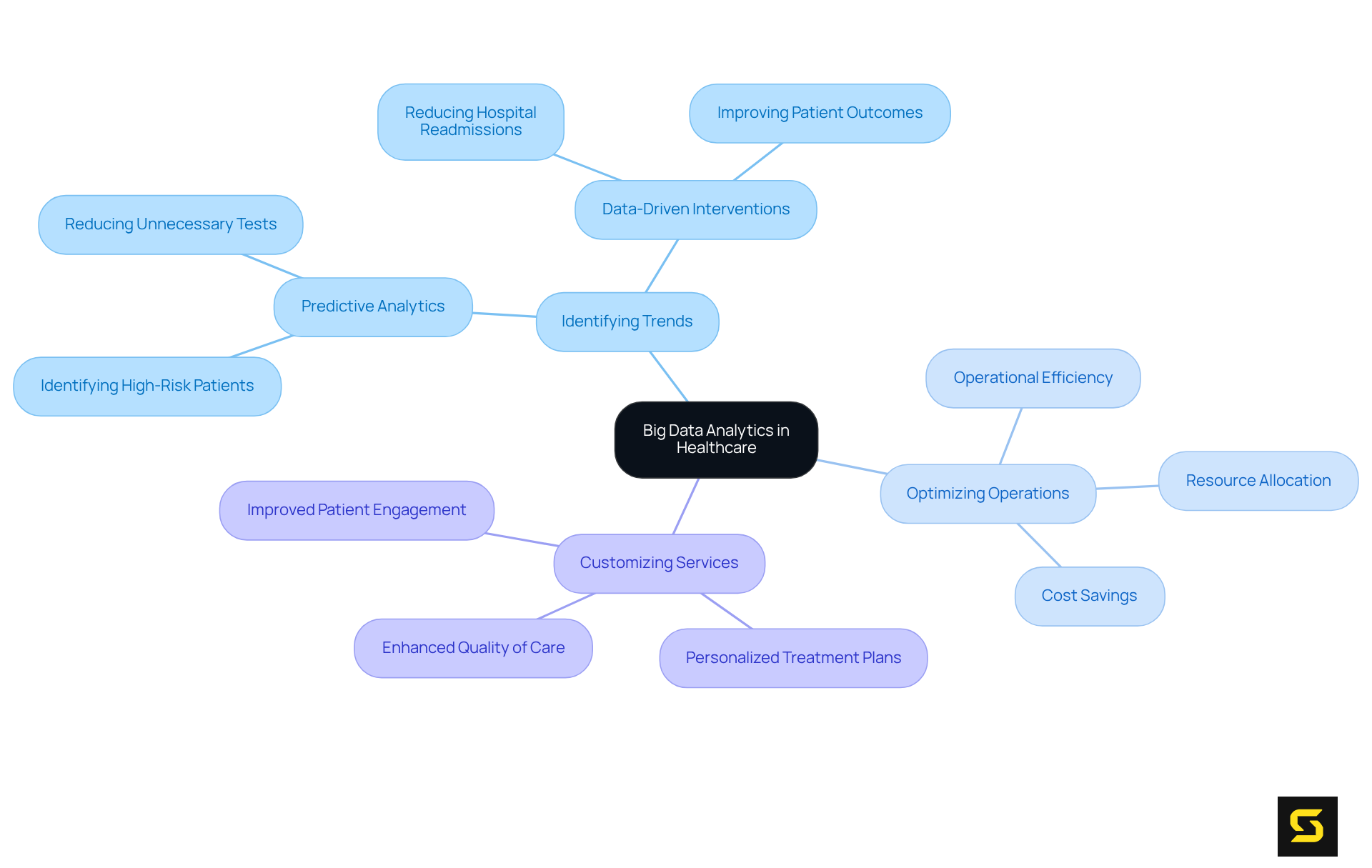
Conclusion
The landscape of healthcare is undergoing a profound transformation, driven by the integration of advanced technologies and innovative solutions. From custom software development to telehealth advancements, the trends highlighted in this article illustrate a pivotal shift towards more efficient, patient-centered care. As healthcare providers embrace these innovations, they not only enhance operational efficiency but also significantly improve patient outcomes. It is essential for stakeholders to stay informed and adapt to this evolving environment.
Key insights from the discussion include:
- The rise of telehealth, which expands access to care
- The role of artificial intelligence in predictive analytics, allowing for proactive health management
- The importance of data interoperability for seamless information exchange
- Wearable technology that empowers patients with real-time health data
- Cybersecurity as a pressing concern, emphasizing the need for robust measures to protect sensitive information
- The adoption of cloud computing and blockchain technology, underscoring the importance of scalable solutions and transparency in healthcare systems
As the healthcare sector approaches 2025, the implications of these trends are significant. Stakeholders must actively engage with these innovations to enhance care delivery, improve patient satisfaction, and safeguard data integrity. Embracing these technologies not only positions organizations at the forefront of medical advancements but also fosters a more resilient and responsive healthcare system, ultimately benefiting individuals and communities alike.
Frequently Asked Questions
What is SDA and what role does it play in healthcare?
SDA is a company that delivers custom software solutions specifically designed to meet the unique needs of healthcare service providers. By focusing on user-centered design, SDA creates intuitive applications that enhance user engagement and satisfaction.
How does SDA's software impact healthcare operations?
SDA's software integrates cutting-edge technologies like telehealth and data management systems, allowing medical organizations to optimize their operations. For example, a secure web-based client payment portal streamlines billing processes, reducing administrative burdens and improving access to services.
What are the projected statistics for the telemedicine market?
The telemedicine market is expected to exceed $115 billion by 2024, highlighting the increasing reliance on technology in healthcare delivery. Additionally, the global telemedicine market was valued at USD 83.4 billion in 2022 and is projected to reach USD 327 billion by 2030.
How does telehealth improve patient care?
Telehealth enhances accessibility for individuals, especially in rural or underserved areas, and supports continuous monitoring and timely interventions. Research shows that remote monitoring programs improve management of chronic conditions, leading to reduced hospitalizations and better health outcomes.
What is the impact of Artificial Intelligence (AI) on healthcare?
AI is transforming predictive analytics in healthcare by enabling providers to anticipate patient needs and optimize resource distribution. By 2025, it is estimated that 80% of hospitals will employ AI to enhance care and workflow efficiency.
What challenges exist in implementing AI in medical services?
Challenges include the need for transparent explanations of AI models and continuous monitoring to ensure successful implementation. These factors must be considered by SaaS product owners developing AI-driven healthcare solutions.
What is the future outlook for AI in healthcare?
Analysts predict that the incorporation of AI in medical services will continue to grow, with 85% of medical leaders planning to invest in generative AI over the next three years, indicating its critical role in shaping future patient care.





